- ALL COMPUTER, ELECTRONICS AND MECHANICAL COURSES AVAILABLE…. PROJECT GUIDANCE SINCE 2004. FOR FURTHER DETAILS CALL 9443117328


Projects > ELECTRONICS > 2020 > IEEE > DIGITAL IMAGE PROCESSING
Image enhancement is an important pre-processing step for many computer vision applications especially regarding the scenes in poor visibility conditions. In this work, we develop a unified two-pathway model inspired by the biological vision, especially the early visual mechanisms, which contributes to image enhancement tasks including low dynamic range (LDR) image enhancement and high dynamic range (HDR) image tone mapping. Firstly, the input image is separated and sent into two visual pathways: structure-pathway and detail-pathway, corresponding to the M- and P-pathway in the early visual system, which code the low- and high-frequency visual information, respectively. In the structure-pathway, an extended biological normalization model is used to integrate the global and local luminance adaptation, which can handle the visual scenes with varying illuminations. On the other hand, the detail enhancement and local noise suppression are achieved in the detail-pathway based on local energy weighting. Finally, the outputs of structureand detail-pathway are integrated to achieve the low-light image enhancement. In addition, the proposed model can also be used for tone mapping of HDR images with some fine-tuning steps. Extensive experiments on three datasets (two LDR image datasets and one HDR scene dataset) show that the proposed model can handle the visual enhancement tasks mentioned above efficiently and outperform the related state-of-the-art methods.
Contrast-limited adaptive histogram equalization (CLAHE)
This paper has following contributions: (1) we built a unified framework for multiple image enhancement tasks, including LDR image enhancement and HDR tone mapping. The strategy of parallel pathways is inspired by the mechanisms of early visual pathway, and can be easily implemented using general structure-texture decomposition methods. (2) Inspired by the recent physiological findings, we proposed an extension of Naka-Rushton equation [40] to integrate the local and global adaptation terms, which demonstrates higher flexibility and better performance in visual local adaptation. (3) A new global-to-local noise estimation strategy was proposed in this paper. We employ a two-step estimation (global to local) methods to estimate the noise level, which achieves good performance on noise suppression and detail preserving.
BLOCK DIAGRAM
